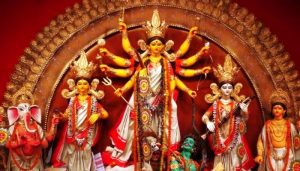| 7 October – 11 October 2016 |
The festival is celebrated with deep zeal and gusto, in West Bengal and Bengalis nationwide, in the form of Durga Puja. The celebrations begin on the first night in the month of Ashwin (September-October).Full of life revelry lasts for ten days, of which nine nights are spent in worship called ‘Navaratri’. The tenth day is dedicated to the worship of goddess Durga, who holds a unique place in the Hindu pantheon of gods and goddesses. She is ‘Shakti’,the celestial force that animates all beings. Beautiful idols of the Mother Goddess are worshipped in prearranged pandals for nine days. On the ninth day, these are carried out in procession for immersion (visarjan) in a river or pond.
celebrated with deep zeal and gusto, in West Bengal and Bengalis nationwide, in the form of Durga Puja. The celebrations begin on the first night in the month of Ashwin (September-October).Full of life revelry lasts for ten days, of which nine nights are spent in worship called ‘Navaratri’. The tenth day is dedicated to the worship of goddess Durga, who holds a unique place in the Hindu pantheon of gods and goddesses. She is ‘Shakti’,the celestial force that animates all beings. Beautiful idols of the Mother Goddess are worshipped in prearranged pandals for nine days. On the ninth day, these are carried out in procession for immersion (visarjan) in a river or pond.
According to a Puranic tale attached to this day, the powerful demon Mahisasur, defeated the gods and their king, Indra, who consequently fled, leaving behind their kingdoms. They came to the Holy Trinity, Brahma, Vishnu and Shiva, who decided to wipe out the dreadful demon. They prayed to the divine mother Durga for help. Armed and riding a ferocious lion, the Goddess in all her tremendous poise defeated the evil. This also celebrates the glory and supremacy of Goddess Durga.
In Tamil Nadu, The first three days are dedicated to-the worship of Lakshmi, Goddess of wealth and prosperity,Next three days to Saraswati, Goddess of learning and art. The last three days to Shakti (Durga), the Goddess of strength.
In Tamil Nadu, Andhra Pradesh and Karnataka, people place dolls (Bommai Kolu) on artificially constructed steps and arrange an elaborate spread of lamps and flowers. They exchange gifts of coconuts, clothes and sweets. Scenes from various stories of the epics and puranas are displayed. It is customary to visit friends on this day. People sing songs, tell stories and relish a dish made out of chickpeas (choondal).The whole set up is put up on the very first day of Navaratri. After the Saraswati pooja on the ninth day, the entire arrangement is taken down on Vijayadashmi. Vijayadashami is a favorable time for children to start their education in classical dance and music, and to pay homage to their teachers.
In Punjab, Navaratri is a time of fasting. In Gujarat, the evenings and nights are the occasion for the enthralling Garba dance. The women dance around an earthen lamp, singing devotional songs accompanied by musical clapping.
In Northern India, the festival sports multicoloured array of Ramlila where various episodes of Rama’s life are enacted, like the destruction of Ravana and Bharat Milap, (the reunion of Ram and his estranged brother Bharat, on the former’s return to Ayodhya after 14 years of exile). In the Kulu valley, Himachal Pradesh, the hill- folk celebrate Dussehra with a splendid mass ceremony, wherein village deities are taken out in an elaborate procession. When Dussehra celebrations come to an end in rest of the country, the celebrations begin at Kullu. Ten days of festivity is a time when the valley is at its best. Multihued processions of devotees bearing gold and silver images of gods and goddesses move to Kullu from all parts of the valley. On the first day, Lord Raghunath is worshipped. Rituals, like the graceful Natti dances, singing and other performances occur for nine days.
As part of the festival, traders from all over the valley set up temporary stalls. They offer woollen shawls, caps, blankets and Pullan (the traditional footwear made from plant fibre and goat hair). This is the finest time to see the crafts of the Kullu valley, especially the traditional clothing of people.
Like other festivals in the country, Durga Puja is an occasion for festivities on a grand scale, which spring a real emotion of kindness and warmth.
